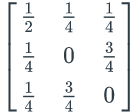Board problem: Write the doubly stochastic matrix
 as a convex combination of
permutation matrices. Show all steps!
as a convex combination of
permutation matrices. Show all steps!
Bonus: Show that no permutation matrix is the convex combination of other permutation matrices (B09, 3 points).
Bonus problem:
- Prove that Floyd algorithm finds the matrix of minimum costs as claimed. (B08, 5 points)
(Mandatory) Board problem: bubble sort (5,1,3,4,2). Show each step as in the notes of October 11.
Bonus questions:
- Find the chromatic polynomial of a cycle of length n. Prove your statement by induction. (B07, 5 points)
Bonus question:
- 2.1/8 (B04, 5 points)
- Prove that the hypercube graph has a Hamilton circuit. (B05, 5 points)
- Prove Grinberg's theorem. (B06, 5points)
Bonus questions:
- Show that for maps with disconnected countries no fixed number of colors suffices to color all maps. (B03, 5 points)
- Special bonus question, due with this assignment: find the formula e=v-1 in the book (provide a page number, and name the kind of graphs it applies to).
Bonus questions:
- Prove that the edge graph of the n-dimensional hypercube is bipartite. (The vertices of the n-dimensional hypercube are all binary strings of length n, two vertices are adjacent when exactly one of their coordinates differs.) (B01, 5 points)
- The Petersen graph is shown in the picture below.
